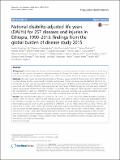| dc.description.abstract | Background: Disability-adjusted life years (DALYs) provide a summary measure of health and can be a critical input
to guide health systems, investments, and priority-setting in Ethiopia. We aimed to determine the leading causes of
premature mortality and disability using DALYs and describe the relative burden of disease and injuries in Ethiopia.
Methods: We used results from the Global Burden of Diseases, Injuries, and Risk Factors Study 2015 (GBD 2015) for
non-fatal disease burden, cause-specific mortality, and all-cause mortality to derive age-standardized DALYs by sex
for Ethiopia for each year. We calculated DALYs by summing years of life lost due to premature mortality (YLLs) and
years lived with disability (YLDs) for each age group and sex. Causes of death by age, sex, and year were measured
mainly using Causes of Death Ensemble modeling. To estimate YLDs, a Bayesian meta-regression method was used.
We reported DALY rates per 100,000 for communicable, maternal, neonatal, and nutritional (CMNN) disorders,
non-communicable diseases, and injuries, with 95% uncertainty intervals (UI) for Ethiopia.
Results: Non-communicable diseases caused 23,118.1 (95% UI, 17,124.4–30,579.6), CMNN disorders resulted in
20,200.7 (95% UI, 16,532.2–24,917.9), and injuries caused 3781 (95% UI, 2642.9–5500.6) age-standardized DALYs
per 100,000 in Ethiopia in 2015. Lower respiratory infections, diarrheal diseases, and tuberculosis were the top
three leading causes of DALYs in 2015, accounting for 2998 (95% UI, 2173.7–4029), 2592.5 (95% UI, 1850.7–3495.1), and
2562.9 (95% UI, 1466.1–4220.7) DALYs per 100,000, respectively. Ischemic heart disease and cerebrovascular disease
were the fourth and fifth leading causes of age-standardized DALYs, with rates of 2535.7 (95% UI, 1603.7–3843.2) and
2159.9 (95% UI, 1369.7–3216.3) per 100,000, respectively. The following causes showed a reduction of 60% or more
over the last 25 years: lower respiratory infections, diarrheal diseases, tuberculosis, neonatal encephalopathy, preterm
birth complications, meningitis, malaria, protein-energy malnutrition, iron-deficiency anemia, measles, war and legal
intervention, and maternal hemorrhage.
Conclusions: Ethiopia has been successful in reducing age-standardized DALYs related to most communicable,
maternal, neonatal, and nutritional deficiency diseases in the last 25 years, causing a major ranking shift to
types of non-communicable disease. Lower respiratory infections, diarrheal disease, and tuberculosis continue
to be leading causes of premature death, despite major declines in burden. Non-communicable diseases also
showed reductions as premature mortality declined; however, disability outcomes for these causes did not
show declines. Recently developed non-communicable disease strategies may need to be amended to focus
on cardiovascular diseases, cancer, diabetes, and major depressive disorders. Increasing trends of disabilities
due to neonatal encephalopathy, preterm birth complications, and neonatal disorders should be emphasized
in the national newborn survival strategy. Generating quality data should be a priority through the development of
new initiatives such as vital events registration, surveillance programs, and surveys to address gaps in data. Measuring
disease burden at subnational regional state levels and identifying variations with urban and rural population health
should be conducted to support health policy in Ethiopia. | en_US |

